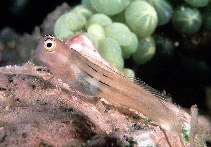| Family: |
Blenniidae (Combtooth blennies), subfamily: Salariinae |
| Max. size: |
4.3 cm TL (male/unsexed) |
| Environment: |
reef-associated; marine; depth range 2 - 11 m |
| Distribution: |
Western Pacific: northern part of the Great Barrier Reef, off Queensland, Osprey Reef in the Coral Sea, and Trobriand Islands of Papua New Guinea. |
| Diagnosis: |
Dorsal spines (total): 12-12; Dorsal soft rays (total): 13-15; Anal spines: 2-2; Anal soft rays: 14-17; Vertebrae: 31-32. Description: Overall grey to tan with horizontal stripes black three lateral and one at dorsal-fin base, may be broken or absent sometimes (Ref. 90102). Detailed color description of live and preserved specimens could be found in Ref. 5296. Osprey Reef and Great Barrier Reef fishes differ in size and color pattern (Ref. 5269). Dorsal fin XII.13-15 (usually 14); anal fin 11,14-17 (usually 16); pectoral fin 12-14 (usually 13); caudal-fin segmented rays 13. Vertebrae 10 + 21-23 (usually 22); dentary incisors and canines very similar in appearance, 42-51, posterior canines 4-8 on each side (rarely 8 unilaterally), but less than 4 in specimens less than 20 mm SL. (Ref. 5296). Posterior rim of anterior nostril with cirrus. Lateral line tube series ends between ninth to twelfth dorsal spine. Body depth 5.7 in SL at anal-fin origin (Ref. 90102). |
| Biology: |
Adults inhabit coral reefs 2-11 m deep (Ref. 90102). Found in shallow areas. Oviparous. Eggs are demersal and adhesive (Ref. 205), and are attached to the substrate via a filamentous, adhesive pad or pedestal (Ref. 94114). Larvae are planktonic, often found in shallow, coastal waters (Ref. 94114). |
| IUCN Red List Status: |
Least Concern (LC); Date assessed: 24 March 2009 Ref. (130435)
|
| Threat to humans: |
harmless |
Source and more info: www.fishbase.org. For personal, classroom, and other internal use only. Not for publication.

